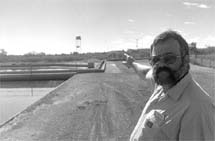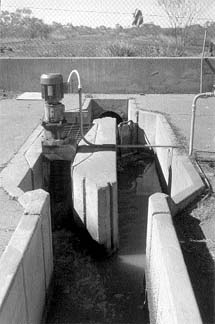So you think you've
got a sh*t job!
Bob Torilla from PAWA shows us what the
tourists don't get to see.
Have you ever wondered what happens when
you pull the chain or press the button? Perhaps not. For most people
out of sight is out of mind when it comes to the most basic of bodily
functions.
Forgive me, I'm even beating around the bush myself. I'm talking about
going to the toilet, the John, the dunny, the bog or perhaps 'the bathroom'
if we're in polite company.
The flushing toilet must rank as one of the great watersheds in twentieth-century
technology! So complete has our acceptance of this convenience become
that some people do not feel comfortable away from the sit down flush
even for short camping trips.
Barkly News Pictorial decided to get to the bottom of the matter (or
the matter of the bottom) and bring you the full story.
We went to see Bob Torilla, Regional Director at PAWA to find out just
where everything ends up. It's only fair to point out that PAWA does
not stand for Poo And Wee Authority - in fact they do make electricity
as well.
Bob told us that after you press the GO button on your Royal Dalton,
your 'effluent' sets off on a trip through a system which consists of
around 18 kilometres of sewer pipes running under the town. There are
1059 homes and businesses connected to this system. You don't have to
worry though, even if your husband seems to spend half his life on the
John, the system was designed for 8,000 bums and we've only got 3,500.
Buried six metres under the ground in some places, the main pipe runs
at a slight decline to the sewage settling pond at the south end of
town. Gravity does most of the work but several low-lying areas in town
need pumps to get up to the main line.
In the early hours of the morning the rate of discharge into the settling
ponds is a tiny six litres per second but when we all fly out of bed
in the morning and start abluting like crazy the trickle becomes a flood
of around twenty litres per second.
Anaerobic Ponds sounds like something you might like to dab your face
with, but this is in fact not so. As it happens, raw domestic sewage
is largely heavy in organic and unsettled particles. The anaerobic pond
is where the heavier particles settle out. Although the ponds are on
average about three metres deep, running near the edge and diving in
from the side are strictly prohibited.
The main pipe from the town goes through the muncher to help break up
the solid bits and then into the primary pond. It takes about 21 days
for around 75% of the solids to settle from the water where they get
broken down by bacteria.
The water then flows to the secondary pond where another 21 days takes
care of the rest of the solids. From here it flows to the tertiary ponds
where the water lies about waiting to evaporate. At present the end
water is not being put to use but Bob Torilla hopes that it will one
day be used for irrigation.
The sewage settling ponds might not be high on your list of places to
visit but they are popular with the town's birdlife. Great flocks of
ducks lumber into the sky when the occasional visitor or worker appears.
"Sometimes we need to go out on the pond in a boat," remarked
Bob. "The blokes don't like going though." That's understandable
enough, for here is the place where nightmares can come true. We all
know the expressions, 'up to your neck in it', for instance; well in
this job you can go a lot further under than that!
Thanks to automation and computers, today's workers can monitor most
functions of the settling ponds from the comfort of command headquarters
back in the PAWA control room. Brett Noye, techno whizz extraordinaire
showed us the monitoring system in action. From the control desk, all
system functions are monitored for the water and sewerage side of things
as well as electricity supply and usage.
Starting with a map of the region, zooms can be made from town view,
to street view, to house view, to the very corner of your block where
the utilities are connected. If the kids lose another cricket ball down
the drain and it somehow manages to find its way down the pipes to the
ponds it may well jam the muncher and this will activate an alarm at
the control desk.
Bob Torilla likes his history. He wants to make a record of the town's
water and sewerage history, so if you've got pictures of night carts
or other records of days gone by, Bob would like to hear from you.
Thanks to PAWA for a job well done.

The primary anaerobic
pond.

Bob Torilla points
to the water tower that was used in the days of night carts. It was
to this place that the full toilet buckets were brought to be emptied
and washed until about 20 years ago.

Brett Noye in the
PAWA control room can zoom in on your workplace, see who's on the toilet
and check to see if you're just reading the paper. Well, not quite yet,
but the technological monitoring is impressive.

This is where it
all comes out, passing through the muncher where your cricket ball will
lodge, causing some alarm at HQ. Small items like diamond rings are
unlikely to appear anywhere in the system so don't drop 'em.